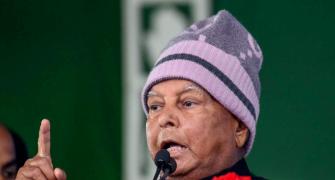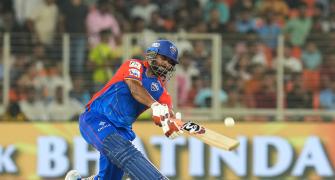This is the last of a four-part series on the DRDO, which has instituted fundamental changes in the way it will approach equipment development.
Part I: New DRDO: An engagement with the military
Part II: New DRDO: Technology first, weapons later
Part III: DRDO's plan for an eye in the sky
Symbolising the Defence Research and Development Organisation's transformed approach to technology is its new direction towards that holy grail of defence technology: the cutting-edge fighter aircraft.
Already, the DRDO-Hindustan Aeronautics Limited combine that is developing the Tejas Light Combat Aircraft, has asked global aerospace majors for help in developing key systems -- the engine, flight controls and aircraft radar amongst them -- which are delaying the entire LCA programme.
And now, in a series of interviews to Business Standard, the DRDO's high priests of technology -- the chief controllers of various divisions -- frankly admit that foreign technological assistance will be essential for India's planned aircraft development programmes: the Fifth Generation Fighter Programme, the Multi-Role Transport Aircraft and the Light Combat Helicopter amongst others.
Dipankar Banerjee, chief controller of aeronautics and materials sciences, explains that a foreign partner will be vital for speeding up delivery; an Indian programme would eventually deliver, but the time frame would be unacceptable to the military.
Banerjee acknowledges, "I don't in the future see a programme without a strong foreign partner. The timelines would be enormous So I don't see a future without a strong foreign partner in the area of fifth generation combat aircraft."
This new outreach from a traditionally inward-focused DRDO is rooted in a realistic assessment that the international sanctions regimes have loosened; global arms majors are eager to provide technologies that can fill in gaps in the DRDO's own technology bank.
The organisation's top scientists believe that the only laws and agreements that continue to restrict technology inflows are:
- The Missile Technology Control Regime.
- The US Department of Commerce's Control List, which lists dual use technologies.
- The ITAR, or International Trade and Arms Regulations of the US.
- The US Department of Energy, Atomic Energy Control Lists.
And even these logjams, it appears from the DRDO's discussions with the US government and arms corporations can be officially bypassed.
For example, Lockheed Martin has offered the DRDO assistance in developing India's anti-ballistic missile ABM) shield, a complex system that the DRDO has successfully tested, but which still holds major technological challenges.
The DRDO is listening carefully to this new talk from a potential technology ally. Says Banerjee, "We have a perception that there could be greater inputs in terms of the variety of technology to DRDO programs from (external) sources from out of the country much of this has arisen from the interactions with the United States."
Now the DRDO has generated a top-secret 'technology wish list', which must be obtained from foreign partners. V K Saraswat, chief controller, missiles and strategic systems reveals, "The document highlights the technology areas in which we would like to have cooperation. This will not be divulged, in case foreign technology developers start clamping down on those (technology) areas."
But still unresolved is the issue of how the identified technology will be obtained. The DRDO wants these technologies to be obtained as a part of offsets; foreign vendors who obtain any contract for supplying defence equipment, must provide the DRDO with high end technology that features on its wish list.
Saraswat reveals that the ministry of defence's director general (acquisitions) has already been given that list of technologies, "to help people to take decisions about what are the areas which we have to negotiate, when we negotiate offsets".
But the MoD feels differently. It has stated publicly that vendors are unlikely to part with cutting edge technology as a part of offsets; instead, the MoD will include its technology requirements in the contract document and pay for it up front.
The request for proposals for supply of 126 medium fighters (worth about $11 billion) has specified the technology that will be provided and paid for. The draft of the new Defence Procurement Policy of 2008, which will be promulgated shortly, does not allow for high technology to be included as a part of offsets.
Either way, the DRDO's new technology wish list will form the basis for technology inflows.







